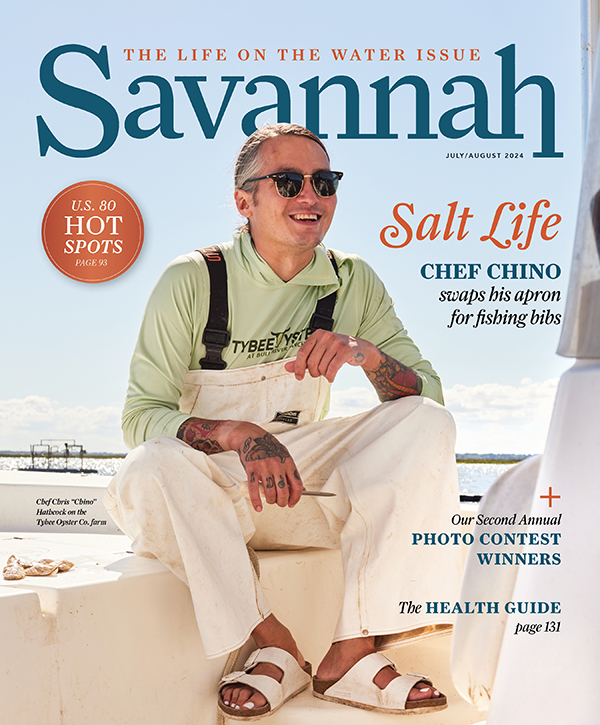Georgia’s third largest barrier island remains largely undeveloped, allowing its native species of plants and animals to thrive
Written by SARA DOMET
Photography by PAUL MEACHAM
THE THIRD LARGEST BARRIER ISLAND in the state of Georgia, Ossabaw Island is a 26,000-acre oasis of varied terrain: old-growth live oaks and longleaf pines; meadowlands, forests, freshwater ponds and saltwater marshlands home to loggerhead sea turtles, wood storks, blue herons, pigs, alligators, donkeys, bald eagles and other protected and threatened species. This pristine and largely undeveloped island, accessible only by boat, is located a mere 20 miles from historic downtown Savannah.
However, the quick facts of Ossabaw Island reveal nothing of its mystery and legacy, nothing of the hypnotic allure of the island that draws people to its shores. “To visit the island is to fall in love with it. You want to go back,” says Brad Christman, a partially retired attorney who began volunteering at Ossabaw 20 years ago, making a twice-annual trek from his then-home in Akron, Ohio, to visit an old friend. This friend happened to be the late Jim Bitler, Ossabaw’s on-island coordinator. Bitler once led Christman out to Spider Ridge, accessible only by foot, a long hike, Christman recalls, where the men stood awed by the mammoth trees anchoring an enormous eagle’s nest.

“As large as a house,” Christman swears. “We watched a mama eagle and her babies in wonder, totally amazed.” Christman soon learned to kayak so he could row out to the island himself, and, unsurprisingly, eventually relocated to Savannah.
The lure of Ossabaw Island is difficult to distill into brochure-worthy bullet points that might tell you the width of the island (7 miles) or minutes from Savannah (30). Such brochures won’t describe what it’s like to walk the main road lined with oak trees at night (spectacular and spooky, according to Christman) or the adrenaline-filled rush from kayaking the alligator-infested Graves Pond on a dare (also spectacular and spooky).
Yet, the island’s visionary steward, Eleanor Torrey West — “Sandy,” to those who knew her — who passed away earlier this year on her 108th birthday, was known to have spit on the island after her parents first purchased it in 1924 as a winter home. “I’ll never love this place,” she said then. How wrong she would be. Not only would West come to love Ossabaw, but she’d also dedicate life and her wealth to preserving it.




According to Elizabeth DuBose, executive director of the Ossabaw Island Foundation, after West inherited the island in 1960, “her first instinct was to throw open the door to the public.” Who could very well blame her for wanting to share the unsullied beauty such as the majestic bones of old live oaks — products of erosion — still rooted on South End Beach or the Native American middens? Natural landscapes invite contemplation and introspection; West knew this from her own experiences.
DuBose explains West believed we gain much from “quieting our minds and allowing ourselves to think differently and be challenged.” West soon began The Ossabaw Island Project, a salon of sorts, dedicated to intellectual and creative inquiry. This interdisciplinary fellowship program ran from 1961–1983 with West handpicking notable linguists, artists, musicians, historians and scientists, among others, to draw inspiration from the island and to challenge one another with competing ideas. Now, in an age of disruptive screens and social-media-induced echo chambers, West’s vision proved to be progressive, if not downright pioneering. Famous visitors to the island include writers Annie Dillard, Ralph Ellison and Margaret Atwood; composers Aaron Copeland and Samuel Barber; and ecologist Eugene Odum.

Stymied by increasing property taxes, in 1978 West would sell the island to the state of Georgia for $8 million, less than half its appraised value. By relinquishing ownership to the state instead of the highest bidder (including Aristotle and Jackie Onassis), West would prevent development on the island in perpetuity and ensure the land was used only for natural, cultural, scientific or educational purposes. When asked about the sale of the island and the loss of her family’s fortune, she would reply with her signature fierce resoluteness: “I would do
it all again.” West remained on the island until she was 103, when declining health forced her to the mainland.
“No one leaves this place unchanged,” says Danèlle Lejeune. She would know. In 2014 she attended the Ossabaw Writers’ Retreat as a “pig farmer pretending to be a poet.” For years she had set aside her own aspirations as a poet for marriage and motherhood. When she read about the feral pigs on Ossabaw, she used it
as her excuse to apply to a retreat that would take her far away from her home in the snowy Midwest.

“This landscape is so frozen in time, untouched by modern development that stories just drip from the trees, sneak up on you in the forest,” she says. Immersed in the enchanting beauty of the island — her early morning hikes, the sunrises that she describes as “no blazing dramatic production, just a slip of blue, silky white” — Lejeune began to recognize something familiar: herself. The quiet, natural splendor of the island was, for her, transformative.
“This place has a hold over me I can’t explain,” she says. “Ossabaw is a place where people see the poet and artist in themselves.” Not only does Lejeune now actively publish her poetry, but she also serves as the assistant director of Ossabaw Writers’ Retreat.

Meaghan Gerard, communications and administrative director for the Ogeechee Riverkeeper, also visited the island to foster the artist within her who was so often overshadowed by the demands of everyday life. “It’s hard for a writer or any kind of artist to carve out headspace to sit with a project,” she says. For Gerard, who was working through a draft of her novel, the island allowed her the opportunity to disconnect in order to free her mind for creative tasks, and this often took the form of exploring the island, meandering.
“History has been well-represented on the island,” says Gerard, noting that her wanderings often took her past the built environment, relics of a different era. “Many people think of Ossabaw as untouched, but it’s been inhabited. Time stamps are there. You can walk past the tabby slave cabins and the mansions and see the vast disparity of wealth.”

Recently the Ossabaw Island Foundation hosted Descendant’s Heritage Day, which invited people with connections to the island from 1760–1960: tenant farmers, Torrey family employees, freedmen, enslaved people and the various groups that hunted, farmed or harvested the island. More than 50 people came together to break bread and to share stories about the island that left an imprint on their lives.
Executive Director DuBose emphasizes the interdisciplinary vision of West. Now, the Foundation hosts an array of programming ranging from archeological digs hosted by the University of Georgia, to turtle-hatching trips, to indigo dyeing workshops, to Savannah’s African American History Museums’ tours. “What I wish more people knew is that you can visit. We want you to visit!” she says.
Had a different kind of heir inherited a gorgeous, historic, largely uninhabited island in 1960, an heir with a gimlet-eyed interest in building off that natural capital, the story of Ossabaw would surely read differently. “Ossabaw is just like Hilton Head, but closer to Savannah,” people might be saying now. “Have you been to the outlet malls there?” Instead, Savannahians and visitors have a glorious green jewel, a gift for those who wander to its shores.


